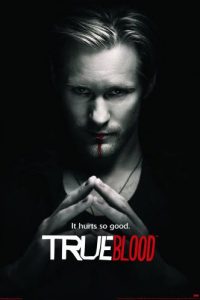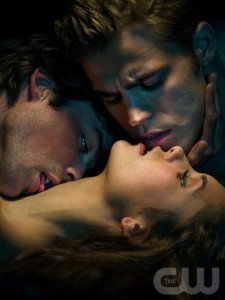Tales of vampires continue to circle the globe, taking on different meanings which are specific to generation and culture. When vampires made their first appearance, they were far from the seductive creatures that we visualize today. As vampires have evolved, so too has their ability to tempt us. From the (literally) dazzling vampires of Twilight to the brooding Nordic nightwalker Eric of “True Blood,” it is the marriage of dark and light, represented in the vampires’ physical bodies and black souls, that leaves us breathless.
Bram Stoker breathed new life into vampire mythology with publication of his 1897 novel, Dracula. Through a series of letters and newspaper clippings, he tells of a vampire that wants to live in the modern world. We learn of the count’s heartbreaking beauty and his ability to bond with humans through the sharing of blood, thus establishing a hold and a form of control. Wilhelmina Murray, the female protagonist, finds that she is unable to defend herself against the advances of the dark count.
Many themes of Stoker’s novel are easily recognizable in the vampire lore of today. Throughout the Twilight saga, Meyer repeatedly reminds the reader of how alluringly beautiful the Cullen family is. When Edward first reveals his body to Bella, she is overwhelmed, because it “glitters like diamonds” in the sun. Clearly, this not a human characteristic and yet the image is enough to solidify her erotic captivation with him. Unlike Wilhelmina, Bella is well aware of what she is looking at. Even though Edward is fang-less, and thus playing upon vampire myths of old, it is the venom that makes his skin sparkle, reminding the reader that even in his beauty there is cause to recognize the danger he poses to humans.

Even when vampires come out of the coffin, as in the hit series “True Blood,” they still possess the ability to both intimidate and lure human companions. Sookie Stackhouse becomes the fixation of two vastly different vampires. Bill, the Civil War-era vampire, continually professes his love and seeks to protect Sookie from every difficulty that she encounters. However, the handsome Nordic vampire, Eric, also desires her and tricks her into drinking his blood, ensuring that a permanent connection between the two of them will always exist.
In Bill, we see new vampire: a creature that seeks to deny his nature because he finds feeding on human blood to be abhorrent. He is constantly in search of his lost humanity – a tragic hero that the viewer is meant to sympathise with. This softer image of the vampire has become quite popular. It can be seen again in the “vegetarian,” or the strictly animal blood diet of the Cullen family in Twilight.
Sympathetic though Bill may be, Eric remains the great seducer. He is powerful, yet extremely understated. He has no fear and this is reflected in his every movement. He desires Sookie because she is different from ordinary humans, but most importantly because she belongs to someone else. Eric is not the type of creature used to having his desires stymied in any way; the more Sookie denies him, the more he wants her. Eric is the quintessential modern vampire: he is beautiful, powerful, and highly sexual, with more than a hint of danger. Even as he inspires fear, he inspires feelings of lust.
The good vs. bad vampire motif is repeatedly played out in the modern vampire stories. In “The Vampire Diaries,” Stefan and Damon are two brothers who are forever united by dark gifts that battle with one another. Damon feeds on human blood with abandon and is not averse to using his abilities to force humans into submitting to his demands. Stefan, another vampire, is only motivated by love of a beautiful human named Elena. He, like the Cullens, lives on the blood of animals. As a day walker, Stefan regularly interacts with humans. Both brothers are handsome and each pulls the viewer in different ways. Regardless of their differing moral positions, it is undeniable that both brothers rely upon their physical beauty to ingratiate themselves in their human interactions.
The modern vampire is the embodiment of beauty. Even Anne Rice’s eternal prankster, the brat prince Lestat in Interview with the Vampire, practically glowed on the page. Regardless of whether or not the various vampires are pining over their lost souls, or running brashly into the night, eternal beauty binds them in complete opposition to the original lore of bloated bodies oozing blood. This perhaps is the best manifestation of modern values: in every culture, there is some form of hierarchy that asserts itself, and physical beauty remains one of the most sought after attributes.

Simply adoring their beauty allows us to hide our attraction to the darkness that each vampire embodies. With some, like Eric from True Blood, the dark side of his nature is constantly on display, whereas for Stefan of “The Vampire Diaries,” it smoulders right near the surface. The vampire reflects a version of humanity that we don’t necessarily want to face. The vampire is ruled by passion, and is extremely powerful and narcissistic. In order survive in the communal fashion that is necessary for human society, these are characteristics which we must strictly discipline; yet in quieter moments, a desire to act on baser instincts exists within each of us. Even as we eschew the coercive aspects of the way in which power manifests itself, we seek it, sure in the knowledge that the ability to oppress negates the various marginalizations that we all face.
Finally, the immortality that is common to all vampires is probably the least discussed feature of their attraction. From the moment we take our first breath, our bodies are decaying. The finite nature of human life and fear of death quite unconsciously creates a longing to live forever. We imagine the historical upheavals that a vampire may have witnessed and this further reminds us of the brief length of our own existence; in this way, Dorian Gray is alive in each human being. The dark trick comes at a cost, though. It may bring an end to the fragility of our human bodies, it risks our souls.
It is the dilemma between loss and possible reward that continues to fascinate us. We may have wrapped the complexity of our vampire fascination in references to the occult, but in truth, it represents the facets of human nature that we seek to disown.

THe vampire has been part of folk lore for centuries, and for good reason. the vampire has many of the strengths and abilities that we would love to have. Who wouldn’t want to be able to climb trees like you were jogging on a backwoods trail? Who wouldn’t want to be smarter, more handsome,and stronger than even the bruce willis’ we see on the screen? Yes, the vampire has much of what we would like to be.
There is a new vampire in town, the psychic vampire. This one does not do the biting and blood drinking. In fact, you’d think this vampire is pretty harmeless, but………….. Thry reading Holden Herbert’s latest book, Annies Gift. This is a great look at the psychic vmapire. Yes, it too is sexy, scary and throws in some humor as well. Check it out on Amazon….You’ll be glad you did.
You nailed it (or should I say fanged it?) with the dilemma between loss and possible reward. I’m fascinated with fictional vampires as romantic heroes. They’re the quintessential Alpha males…strong, silent types who are uber-sexy and always ready to protect and defend their women. That’s how I write mine, at least.
Someone please create a sexy brooding Vampire that has a thing for Black women…we’d like to get in on this action too!
Great post. Perhaps we love them though because we DO want to look in the mirror — to gaze into our “darker” desires while we simultaneously pretend these are not human, but vampire…
In addition to the immortality, beauty, and power of the vampire that you explore, I think it is also important to consider the vampire as a symbol of imperialism and colonization — as taking over other lands/humans, etc. Stoker was certainly engaging in this debate as his dark Count invaded the pristine English shores.